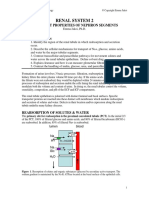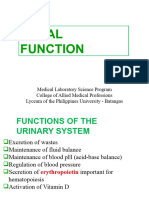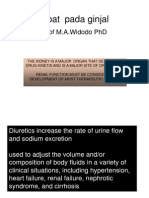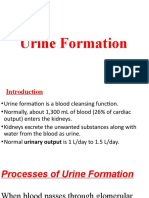Cicm Part 1 Study
Cicm Part 1 Study
Uploaded by
Reesha CornelioCopyright:
Available Formats
Cicm Part 1 Study
Cicm Part 1 Study
Uploaded by
Reesha CornelioCopyright
Available Formats
Share this document
Did you find this document useful?
Is this content inappropriate?
Copyright:
Available Formats
Cicm Part 1 Study
Cicm Part 1 Study
Uploaded by
Reesha CornelioCopyright:
Available Formats
[Year]
PART 1 – EXAM STUDY
CICM
Reesha Cornelio
1: Renal Physiology
Describe the functional anatomy of the kidneys.
Describe renal blood flow and its regulation.
Describe glomerular filtration and tubular function.
Explain the counter-current mechanisms in the kidney.
Describe the functions of the kidney.
Describe the physiological effects of renal dysfunction.
H2 Applied Renal Physiology
Describe the principles of dialysis and filtration.
H3: Renal Pharmacology
Understand the pharmacology of diuretics.
Understand the pharmacology of renal replacement fluid.
H4: Renal Measurement
Describe the principles of measurement of glomerular filtration rate and renal blood flow.
Describe the utility of biochemical estimates of renal function (including but not limited to the
measurement of serum creatinine, cystatin C and estimates of Creatinine Clearance such as
eGFR).
DESCRIBE THE FUNCTIONAL ANATOMY OF THE KIDNEYS.
Gross anatomy
Paired abdominal (retroperitoneal) organ
Right kidney is related to liver, duodenum, ascending colon, small intestine.
Left kidney is related to spleen, stomach, pancreas, descending colon.
Both kidneys are superiorly related to an adrenal gland, and posteriorly to rib 12, the diaphragm,
psoas major, quadratus lumborum and transversus abdominis
Blood supply: single renal artery
Venous drainage: single renal vein
Lymphatic drainage: renal hilar nodes and then lumbar nodes.
Innervation:
efferent is strictly sympathetic, from T9-T13
afferent (pain) via the least splanchnic nerve (T12)
DESCRIBE THE RENAL HANDLING OF SODIUM
Reabsorption or tubular reabsorption is the process by which the nephron removes water and solutes
from the tubular fluid and returns them to the circulating blood.
secretion is the process of adding substances from the kidbey into the renal tubule
Sodium is freely filtered in the glomerulus
65% is then reabsorbed in the PCT
o The reabsorption is driven by a concentration gradient created by the action of the
basolateral Na/K ATPase
o Most of the sodium is
reabsorbed by the NHE3
sodium hydrogen exchanger.
o Other transport proteins
including SLG2, phosphate co-
transporter Np2a and
multiple organic anion co-
transporters.
None is reabsorbed in the thin
descending limb.
o It is impermeable to sodium
Some minimal amount is reabsorbed in
the thin ascending limb
o It is permeable to ions, but
not to water
o Some sodium is reabsorbed
but passively here
25% is reabsorbed in the thick ascending limb
o Most of this is by the frusemide-sensitive NKCC2 co-transporter
5-10% is reabsorbed in the distal convoluted tubule
o Most of this is by the thiazide sensitive NCC co transporter.
The sodium-chloride symporter (also known as Na+-Cl− cotransporter, NCC or NCCT,
or as the thiazide-sensitive Na+-Cl− cotransporter or TSC) is a cotransporter in the
kidney which has the function of reabsorbing sodium and chloride ions from the
tubular fluid into the cells of the distal convoluted tubule of the nephron.
o This step is loaded-sensitive, reabsorption increases if there is increased sodium delivery to
this segment
2% is reabsorbed in the collecting duct
o Most of this is passive, via the amiloride-sensitive ENaC channel
How is sodium reabsorption regulated?
Angiotensin II increases reabsorption by (increases reabsorption by increasing Na+/K+ ATPase
activity in the proximal tubule, and increases NHE3 activity)
Aldosterone increases ENAC activation in the collecting duct and NA/K/Atpase activity in the thick
ascending limb
Vasopressin increases expression of ENAC in the collecting duct and NKCC2 in the thick ascending
limb
Catecholamines by increases NKCC2 expression in the thick thick ascending limb
Describe the types of sodium transporters.
The NHE3 antiporter imports one sodium ion into the cytosol of a tubule cell
as it ejects one hydrogen ion from the cell into the lumen of the proximal
tubule
o Lives in the PCT
The Na+/K+-ATPase enzyme is active (i.e. it uses energy
from ATP). For every ATP molecule that the pump uses, three
sodium ions are exported and two potassium ions are imported
ENaC activity is finely controlled through proteolytic activation, a process wherein specific
enzymes, or proteases, cleave ENaC subunits, resulting in channel activation and increased
sodium reabsorption
What is the total sodium load and reabsorption?
Sodium handling in the proximal tubule
You might also like
- Chapter 27 GuytonDocument6 pagesChapter 27 GuytonGabriella ChafrinaNo ratings yet
- 6-Drugs Acting On The Renal System - 2Document65 pages6-Drugs Acting On The Renal System - 2Hamid Hussain HamidNo ratings yet
- PHS RenalDocument44 pagesPHS Renaltewogbadeomobuwajo005No ratings yet
- Tubular ReabsorptionDocument42 pagesTubular Reabsorptionmina mounirNo ratings yet
- 2 - Renal Secretion & AbsorptionDocument14 pages2 - Renal Secretion & AbsorptionHamzehNo ratings yet
- 7,8-Handling of Na+ & Glucose by The Renal TubulesDocument11 pages7,8-Handling of Na+ & Glucose by The Renal TubulesOsama MohamedNo ratings yet
- L3 +L4 Renal System 2023Document31 pagesL3 +L4 Renal System 2023mizare29gNo ratings yet
- General Principles of Tubular ReabsorptionDocument54 pagesGeneral Principles of Tubular ReabsorptionRalph JacintoNo ratings yet
- L5&6-Tubular Reabsorption& SecretionDocument38 pagesL5&6-Tubular Reabsorption& SecretionsairahhannahNo ratings yet
- Physio 2Document6 pagesPhysio 2Mohammad AlomariNo ratings yet
- Lec 14 - Kidney PDFDocument16 pagesLec 14 - Kidney PDFrajeshNo ratings yet
- Chapter 24. The Kidney.: 1. The Structure and Function of The NephronDocument8 pagesChapter 24. The Kidney.: 1. The Structure and Function of The NephronjeskevandiemenNo ratings yet
- Renal System 2: Transport Properties of Nephron SegmentsDocument5 pagesRenal System 2: Transport Properties of Nephron SegmentsSherida GibbsNo ratings yet
- DCT and Collecting DuctDocument29 pagesDCT and Collecting DuctayeshaNo ratings yet
- Chapter 18 DIURETICSDocument14 pagesChapter 18 DIURETICSAlexandra AlexaNo ratings yet
- Handling of Certain Important Solutes by The Renal TubulesDocument14 pagesHandling of Certain Important Solutes by The Renal TubulesOsama MohamedNo ratings yet
- Part 1 - US-Grade 4-BiochemistryDocument34 pagesPart 1 - US-Grade 4-BiochemistryFarah Bashar Al-RawachyNo ratings yet
- Tubular Reabsorption and Secretion: by Dr. Rukhsana AnwarDocument49 pagesTubular Reabsorption and Secretion: by Dr. Rukhsana AnwarZia PhotostateNo ratings yet
- Renal SystemDocument91 pagesRenal SystemKetheesaran LingamNo ratings yet
- LOOP OF HENLE (Modified)Document25 pagesLOOP OF HENLE (Modified)Chuleha SethNo ratings yet
- Pharmacology of Renal SystemDocument125 pagesPharmacology of Renal SystemBirhanu Geta100% (1)
- Handling of Certain Important Solutes by The Renal Tubules: Prof./ Ibrahim Mohamady IbrahimDocument39 pagesHandling of Certain Important Solutes by The Renal Tubules: Prof./ Ibrahim Mohamady IbrahimOsama MohamedNo ratings yet
- Transport Mech 09192011Document38 pagesTransport Mech 09192011Wesley SeeNo ratings yet
- Mechanism of Filteration of Urine 5Document34 pagesMechanism of Filteration of Urine 5Akshay Pratap SinghNo ratings yet
- Renal SystemDocument195 pagesRenal System7bzhbznbdmNo ratings yet
- Test 4 Renal Gi Met DM AgingDocument9 pagesTest 4 Renal Gi Met DM AgingmeganNo ratings yet
- Urine Formation: Tubular Processing of The Glomerular FiltrateDocument131 pagesUrine Formation: Tubular Processing of The Glomerular Filtrateabstabs100% (1)
- Presentation 3Document11 pagesPresentation 3Najma xaaji caliNo ratings yet
- SHS.108.Lect-10 Tubular ReabsorptionDocument61 pagesSHS.108.Lect-10 Tubular ReabsorptionAzlan YasirNo ratings yet
- What Is Diuretic? Classify Diuretics? A Diuretic Is DefinedDocument3 pagesWhat Is Diuretic? Classify Diuretics? A Diuretic Is DefinedSujan Bose100% (1)
- Tubular Function (Distal Tubule)Document26 pagesTubular Function (Distal Tubule)Hakimah K. SuhaimiNo ratings yet
- L4 Regional Transport 2023Document4 pagesL4 Regional Transport 2023bgj9cddvxhNo ratings yet
- Physiology c6Document39 pagesPhysiology c6paulos asefaNo ratings yet
- UNIT-V_PharmacologyofDrugsactingonRenalsystem__DiureticsDocument20 pagesUNIT-V_PharmacologyofDrugsactingonRenalsystem__Diureticsrroshinee99No ratings yet
- Renal Extra Notes: Total Body Water (TBW) 0.6 X Body WeightDocument3 pagesRenal Extra Notes: Total Body Water (TBW) 0.6 X Body WeightKhaing26No ratings yet
- 1 Renal Function - 20Document76 pages1 Renal Function - 20krystelmae009No ratings yet
- 9.distal Tubule Balance and Tubuloglomerular Feedback-Group 2Document33 pages9.distal Tubule Balance and Tubuloglomerular Feedback-Group 2HAMISI MAKWAYANo ratings yet
- Biokimia UrinDocument2 pagesBiokimia UrinAswin AgusNo ratings yet
- Electrolyte Balance 2023Document51 pagesElectrolyte Balance 2023Salmonella TyphiNo ratings yet
- Diuretics 1Document38 pagesDiuretics 1kreem.alzebakNo ratings yet
- Fundamentals of Medical Physiology Harminder - Unlocked - Split - 62Document5 pagesFundamentals of Medical Physiology Harminder - Unlocked - Split - 62maruf141992No ratings yet
- Obat Pada Ginjal: Prof M.A.Widodo PHDDocument53 pagesObat Pada Ginjal: Prof M.A.Widodo PHDPriiya Ashiwini100% (1)
- Chapter 28 14th EdDocument90 pagesChapter 28 14th EdchayChay gapolNo ratings yet
- UrinaryDocument87 pagesUrinaryJohn Paolo Dalida SalazarNo ratings yet
- Compare and Contrast Ionic Movements Across Renal and Digestive Tract EpitheliaDocument2 pagesCompare and Contrast Ionic Movements Across Renal and Digestive Tract EpitheliaDhruvalNo ratings yet
- DiureticsDocument37 pagesDiureticsRutvik ShahNo ratings yet
- SODIUMDocument4 pagesSODIUMNorhidayah NoordinNo ratings yet
- Renal Physiology BY Dr. Olasupo. S. AdeniyiDocument6 pagesRenal Physiology BY Dr. Olasupo. S. AdeniyiUloko ChristopherNo ratings yet
- Distal Tubule Balance and Tubuloglomerular Feedback-Group 2Document42 pagesDistal Tubule Balance and Tubuloglomerular Feedback-Group 2Chuleha SethNo ratings yet
- 5 RenalDocument10 pages5 RenalAli EllaffiNo ratings yet
- After Studying This Chapter, Students Should Be Able To - .Document59 pagesAfter Studying This Chapter, Students Should Be Able To - .Deepika MahajanNo ratings yet
- 2013 Renal Tubular AcidosisDocument13 pages2013 Renal Tubular AcidosisLUIS FRANCISCO GUERRERO MARTÍNEZNo ratings yet
- Revision FileDocument14 pagesRevision FileBasema HashhashNo ratings yet
- Tubular Reabsorption and SecretionDocument21 pagesTubular Reabsorption and SecretionAhmad KhanNo ratings yet
- Physio Lecture2Document40 pagesPhysio Lecture2lzghourymedNo ratings yet
- CVS - DiureticsDocument8 pagesCVS - Diureticshlouis8No ratings yet
- MDS 323.1 Tubular reabsorption in the different part of the nephronDocument6 pagesMDS 323.1 Tubular reabsorption in the different part of the nephronmacaulayihcaramaNo ratings yet
- Renal Transport Mechanism (Dr. Hardian)Document21 pagesRenal Transport Mechanism (Dr. Hardian)Theofilus ArdyNo ratings yet
- Renal Pharmacology 2023Document116 pagesRenal Pharmacology 2023sami MesfinNo ratings yet
- PCO Answer Key-RED PACOPDocument40 pagesPCO Answer Key-RED PACOPViviengail GalosNo ratings yet
- In Gel Finger 2015Document10 pagesIn Gel Finger 2015Dumitrache VicentiuNo ratings yet
- L8-Urine Conc.Document15 pagesL8-Urine Conc.Bryn MasvaureNo ratings yet
- Renal Control of Calcium, Phosphate, and Magnesium HomeostasisDocument1 pageRenal Control of Calcium, Phosphate, and Magnesium Homeostasisarnob nNo ratings yet
- Renal Physiology MCQ by DR of 2027-28Document32 pagesRenal Physiology MCQ by DR of 2027-28sadiq.mk.abbasi100% (1)
- Homeostasis FlashcardsDocument46 pagesHomeostasis FlashcardsLejNo ratings yet
- Loop of HenleDocument40 pagesLoop of HenleghenbotrahwaNo ratings yet
- The Sequence of Events That Occur in The Heart During Cardiac CycleDocument13 pagesThe Sequence of Events That Occur in The Heart During Cardiac CycleADITYAROOP PATHAKNo ratings yet
- Urinary SystemDocument22 pagesUrinary SystemGray Odyssey M.No ratings yet
- Renal: Est Autoregulatory SystemsDocument12 pagesRenal: Est Autoregulatory SystemsIdrissa ContehNo ratings yet
- Complete Download Vanders Renal Physiology 7th Edition Mcgraw-Hill PDF All ChaptersDocument60 pagesComplete Download Vanders Renal Physiology 7th Edition Mcgraw-Hill PDF All Chaptersliviejosma9g100% (9)
- P2 2019 SMK Methodist PDFDocument11 pagesP2 2019 SMK Methodist PDFBryanLeeChienYungNo ratings yet
- 7th Lecture - Diluted and Concentrated UrineDocument9 pages7th Lecture - Diluted and Concentrated UrinewarikogatumaNo ratings yet
- HOMEOSTASISDocument21 pagesHOMEOSTASISalyaainsyirah04No ratings yet
- Urine FormationDocument76 pagesUrine FormationPrakash PanthiNo ratings yet
- Urine Formation and Its CompositionDocument22 pagesUrine Formation and Its CompositionZahidKhanNo ratings yet
- Water Regulation - Indd - OsmosisDocument7 pagesWater Regulation - Indd - OsmosisRishi Raj NRNo ratings yet
- Fisiologia Asa de HenleDocument24 pagesFisiologia Asa de HenleOscar SotoNo ratings yet
- Reabsorption (Excretion Physiology)Document28 pagesReabsorption (Excretion Physiology)Ayesha IqbalNo ratings yet
- Water Balance and Regulation of OsmolalityDocument35 pagesWater Balance and Regulation of OsmolalityMaria InolynNo ratings yet
- Kidney Anatomy and PhysiologyDocument17 pagesKidney Anatomy and Physiologytemo chachanidzeNo ratings yet
- Rangkuman Fisiologi Sistem Kemih ManusiaDocument104 pagesRangkuman Fisiologi Sistem Kemih ManusiaPAP BungsuNo ratings yet
- Get Vander s Renal Physiology 7th Edition LANGE Physiology Series Douglas Eaton free all chaptersDocument55 pagesGet Vander s Renal Physiology 7th Edition LANGE Physiology Series Douglas Eaton free all chapterssemprebarawyNo ratings yet
- Ultrafiltration and Selective ReabsorptionDocument22 pagesUltrafiltration and Selective ReabsorptionKemoy FrancisNo ratings yet
- RENAL WORKSHEET Anatomy AnswerDocument10 pagesRENAL WORKSHEET Anatomy AnswerJohnny eawNo ratings yet
- Excretion in MammalsDocument17 pagesExcretion in MammalsKaynat JavedNo ratings yet
- Physio - Water BalanceDocument8 pagesPhysio - Water Balanceavian_rose100% (2)
- Urinary System, Genital System of Veterinary AnatomyDocument30 pagesUrinary System, Genital System of Veterinary AnatomyRadia RaicyNo ratings yet
- Advances in Understanding The Urine-Concentrating MechanismDocument26 pagesAdvances in Understanding The Urine-Concentrating MechanismKiara Lopez RelaizaNo ratings yet
























































































